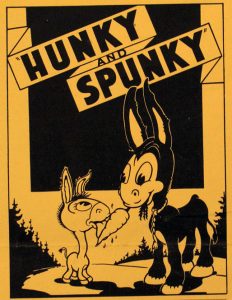 Many animals became animated stars, but no donkey ever entered their ranks. Perhaps the closest contenders were the Fleischer Studio’s Hunky and Spunky. From 1937-1941, this pair of mules (Hunky was the mom and Spunky her son) starred in seven Color Classic cartoons. After Paramount removed the Fleischers, Spunky soldiered alone in two Noveltoons and two further appearances with Casper the Friendly Ghost before disappearing in 1958.
Many animals became animated stars, but no donkey ever entered their ranks. Perhaps the closest contenders were the Fleischer Studio’s Hunky and Spunky. From 1937-1941, this pair of mules (Hunky was the mom and Spunky her son) starred in seven Color Classic cartoons. After Paramount removed the Fleischers, Spunky soldiered alone in two Noveltoons and two further appearances with Casper the Friendly Ghost before disappearing in 1958.
Accurate credits are rare in the Fleischer canon, but it appears that Hunky and Spunky were created and designed by Myron Waldman. Dave Fleischer receives directing credits on all seven shorts but never did so, serving as producer instead. Waldman directed four (all uncredited), including the debut cartoon, Hunky and Spunky, in 1938. That short garnered an Academy Award nomination that year but ran against four Walt Disney entries, losing to Ferdinand the Bull.
It would have been no surprise if Hunky and Spunky turned out to be a one-shot cartoon. The characters are unattractive, with shaggy, unkempt fur, outdated pie-cut eyes, and heads too large for their bodies. Jack Mercer (uncredited) provided the abrasive braying; there is no intelligible dialogue.
Waldman and Graham Place animated the cartoon, but Herman Cohen and Lillian Friedman went uncredited due to the studio policy of denying credits to more than two animators. This practice was especially egregious for Friedman, America’s first female animator, who rarely received credits. This pattern of obscuring directors and animators continued throughout the Hunky and Spunky series.
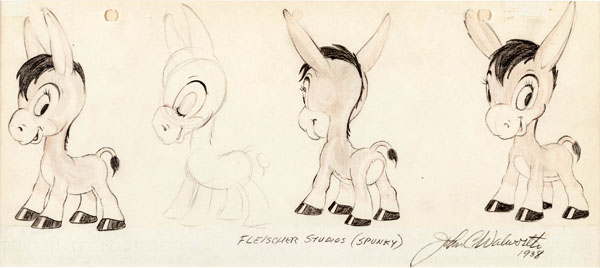
Sammy Timberg provided the musical score. Background/layout artist Shane Miller (also uncredited) used Fleischer’s 3D stereoptical system well.
The threadbare plot, in which a prospector kidnaps Spunky for his pack animal before Momma comes to the rescue, is unremarkable. Shamus Culhane would reuse it in a later Hunky and Spunky cartoon.
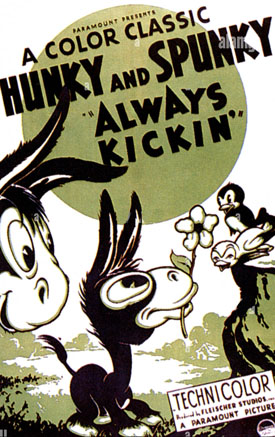 The following cartoon, Always Kickin’ (1/27/39), featured considerable character design and expressivity improvements, although the pie-cut eyes remained. Friedman again went uncredited, with Waldman, who directed, and Arnold Gillespie listed as the animators. Uncredited players also include Jack Mercer (voices), Sammy Timberg (music), and Shane Miller (backgrounds, layout).
The following cartoon, Always Kickin’ (1/27/39), featured considerable character design and expressivity improvements, although the pie-cut eyes remained. Friedman again went uncredited, with Waldman, who directed, and Arnold Gillespie listed as the animators. Uncredited players also include Jack Mercer (voices), Sammy Timberg (music), and Shane Miller (backgrounds, layout).
The story has Spunky rejected by warbling birds, who mock him until he rescues them from a hungry buzzard (almost certainly animated by Waldman) with his kicking prowess.
The Barnyard Brat (6/30/39) features misbehaving Spunky as the bane of the other barnyard animals until a rooster rallies them against the brat. Spunky gets his comeuppance from them, but even after being rescued by Momma, he continues his tantrums until he finally gets a good spanking. It does little to change his ways.
The characters, animated by director Waldman and Tony Pabian (Friedman is again uncredited), regress visually. Jack Mercer’s uncredited vocals are annoying, and despite several good spot gags, there’s no gold here. Sammy Timberg and Shane Miller are again uncredited.
The first entry of the 1940s, A Kick in Time, was notable for Shamus Culhane taking the (uncredited) direction, along with a team of animators assigned to him. Along with veteran Al Eugster (only he and Culhane had animation credits), Reuben Grossman, Abner Knietel, Nick Tafuri, Bob Wickersham, John Walworth, and Hal Seeger worked on the short. Seeger and Culhane would collaborate on the TV cartoon series Milton the Monster almost twenty-five years later.
The short displays many of Culhane’s strengths, including the consistent volume of the characters and improved timing. For the first time, the donkeys display uncut eye pupils. The cartoon is very similar to the first Hunky and Spunky short, with Spunky kidnapped to be a draft animal and rescued by Momma. However, this cartoon is essentially unwatchable due to the severe abuse and cruelty inflicted on Spunky for virtually the entire short. Sammy Timberg is credited this time, but Shane Miller is not.
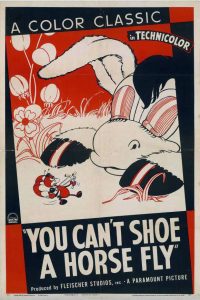 There would be three more entries in the series. Covering them in detail is almost redundant; the same personnel appears in virtually every one, save for Pinto Colvig, who teamed up with Jack Mercer on vocal work in the two subsequent cartoons. The shorts Snubbed by a Snob (7/19/40), You Can’t Shoe a Horsefly (8/23/40), and Vitamin Hay (8/22/41) all reflect a declining animation studio.
There would be three more entries in the series. Covering them in detail is almost redundant; the same personnel appears in virtually every one, save for Pinto Colvig, who teamed up with Jack Mercer on vocal work in the two subsequent cartoons. The shorts Snubbed by a Snob (7/19/40), You Can’t Shoe a Horsefly (8/23/40), and Vitamin Hay (8/22/41) all reflect a declining animation studio.
By the waning days of 1939, Betty Boop was gone, and Fleischer did not even own their remaining stars – Popeye and Superman. The studio instead put costly efforts into producing two feature films. The final Hunky and Spunky cartoon came out as Paramount was calling in the studio’s debts, and Max and Dave Fleischer were not even on speaking terms.
The studio’s last gasp was likely the two excellent Superman cartoons released under the Fleischer aegis. Hunky and Spunky never developed into fan favorites, and neither did the flurry of Stone Age cartoons that the studio launched in 1940.
Hunky vanished, but Spunky went on to star in four Paramount shorts directed by various animators and not, as credited, Izzy Sparber. Yankee Doodle Donkey (11/27/44) found the burro trying to enlist in a cadre of military dogs. The bulldog colonel rejects him, but Spunky saves the colonel and the regiment from an invading flea army.
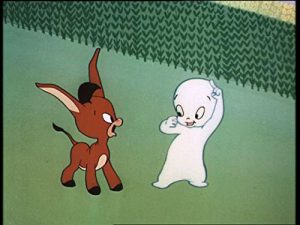 The cartoon is one of the best Spunky appeared in. The direction, by Nick Tafuri, is snappier. The animation (also by Tafuri, plus Tom Golden and John Walworth, all uncredited) far surpasses previous Hunky and Spunky cartoons. Winston Sharples turned in a livelier musical arrangement than Sammy Timberg’s prior efforts, and there are more frequent gags.
The cartoon is one of the best Spunky appeared in. The direction, by Nick Tafuri, is snappier. The animation (also by Tafuri, plus Tom Golden and John Walworth, all uncredited) far surpasses previous Hunky and Spunky cartoons. Winston Sharples turned in a livelier musical arrangement than Sammy Timberg’s prior efforts, and there are more frequent gags.
Eleven years passed before Spunky reappeared in the Casper the Friendly Ghost cartoon Boo Kind to Animals (12/23/55). Casper helps Spunky win a place in the Army as a medical transport mule. Tom Golden directed, and Robert Owen is credited with background/layout for the first time. Interestingly, an all-star vocal cast consisting of Jack Mercer, Gwen Davies, Jackson Beck, and Sid Raymond all go uncredited.
Spunky also appeared in three short non-speaking cameos in the Casper cartoon Ghost of Honor (7/19/57), the first time painted on an animation cel!
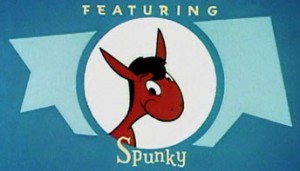 The curtain closed on the doughty donkey with Okey Dokey Donkey (5/16/58), directed by Al Eugster, who also animated. Poor Spunky is animated in a jerky style heavily reminiscent of UPA animation, with thick black lines around his body, and the design of Marilyn, his carousel horse date, consists of contrasting graphic lines. The background art of John Zago also represents UPA’s influence. The cartoon’s carelessness shows when Spunky and Marilyn address each other by name, absent a scene in which they initially learn them. Gilbert Mack gives Spunky a human voice for this finale.
The curtain closed on the doughty donkey with Okey Dokey Donkey (5/16/58), directed by Al Eugster, who also animated. Poor Spunky is animated in a jerky style heavily reminiscent of UPA animation, with thick black lines around his body, and the design of Marilyn, his carousel horse date, consists of contrasting graphic lines. The background art of John Zago also represents UPA’s influence. The cartoon’s carelessness shows when Spunky and Marilyn address each other by name, absent a scene in which they initially learn them. Gilbert Mack gives Spunky a human voice for this finale.
Spunky was a better character on his own, and, regrettably, Paramount did not give him more team-ups with the Harveytoon cast of stars besides Casper. Still, with a twenty-one-year career at two different studios, Spunky can’t kick!


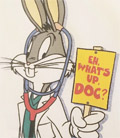 Martin Goodman is a veteran writer specializing in stories about animation. He has written for AWN and Animation Scoop – and lives in Anderson, Indiana.
Martin Goodman is a veteran writer specializing in stories about animation. He has written for AWN and Animation Scoop – and lives in Anderson, Indiana.


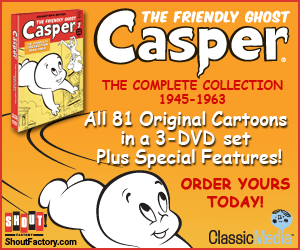
























“Many animals became animated stars, but no donkey ever entered their ranks.”
What about “Donkey” from the “Shrek” franchise?
There’s nothing like an Academy Award, or at least a nomination, for turning one-off cartoon characters into stars of a series. At Disney, the Three Little Pigs, the Three Orphan Kittens, and the Tortoise and the Hare all won Oscars, and they were all given sequels. Over at UPA, Gerald McBoing Boing won an Oscar, and he got three sequels and a TV show. Does anyone believe there’d be as many Pepe Le Pew or Speedy Gonzalez cartoons as there are if the early ones hadn’t won Oscars? Since Academy Award nominations were rare for the Fleischer studio, and wins were unknown, I suppose Max and Dave felt they should make the most of whatever honours came their way. That’s why we have three Popeye two-reelers, seventeen Supermans, and a whopping seven Hunky and Spunky cartoons.
One wonders what the Academy saw in “Hunky and Spunky” that inspired them to put it in the same favoured class with “Ferdinand the Bull”, “The Brave Little Tailor”, and “Mother Goose Goes Hollywood”. If any Color Classic of 1938 deserved to be nominated for an Academy Award, it was “All’s Fair at the Fair”. If it had been, we might then have had a whole series of cartoons starring rubes Elmer and Miranda and their horse Dog Biscuit, instead of those two infernally braying macrocephalic perissodactyls. History shows that the cartoons honoured by the Academy are only rarely the best ones of the year.
I guess Eeyore and the donkey in the Shrek movies don’t count as animated stars, since they’re supporting characters, even though they’re far more popular than Hunky and Spunky ever were. Baba Looey was a sidekick, not a star. Then there was old Doc Donkey, who starred in a couple of MGM cartoons during the war years, but he never really caught on.
Good riddance, Hunky and Spunky. Hit the road, you silly asses, and keep a-goin’.
“History shows that the cartoons honoured by the Academy are only rarely the best ones of the year.”
Amen to that. Even beyond Hunky and Spunky, as well as Disney hogging the Oscar wins in the 1930s, if these awards actually celebrated the ‘best of the best’, Tom and Jerry wouldn’t have won as many times as they did from 1943 to 1952 considering Tex Avery’s presence at the same studio (let alone what WB was putting out those years beyond Tweety and Pepe).
Geez, I happen to like those award winners.
Paul, thanks for defending my choice of H&S as the only “star” donkeys. I am willing to concede to the other posters and revise my opening statement to “…very FEW donkeys.” However, my only point of contention is that I consider Eeyore a literary character who was not created in any animation studio and was a “star” through adaptation only.
One oddity, of course, is that mules (the product of a mating between a female horse and a male donkey) can’t breed — they’re sterile. Which does make you think that they’re donkeys.
Just to be clear, the fact that mules are sterile doesn’t mean they abstain from sex. Unless they’re gelded, they’ll get up to just as much hunky-punky as their purebred cousins.
When I’m watching my various classic animation video collections, I always watch everything. I enjoy looking for the good elements in even the “lesser” toons.
With exactly one exception.
When H&S pop up, I can’t hit the Next-Chapter button fast enough.
OK. but say paramount studios agreed with thunderbean on a complete hunky and spunky set and added the harveytoons era ones with Universals blessing.
would YOU order the set?
How Hunky and Spunky could have made it past one cartoon, let alone an Oscar nomination, with those gruesome character designs and screechy voices is beyond me. The theme song wasn’t bad, though. With the short cartoons getting progressively worse (even Popeye, but to a lesser degree) and two features failing to set the world on fire, it’s no wonder Paramount dumped the Fleischers, which is almost karma for them dumping Bimbo and Ko-Ko. “Okey Dokey Donkey” is an uncommonly charming cartoon for Famous, though; they finally made Spunky cute.
I always had a soft spot for Hunky and Spunky. Their films weren’t very good but I was nevertheless always entertained by them. I particularly enjoyed the bull’s nonsense song in “Snubbed by a Snob” and the horsefly’s song in “You Can’t Shoe a Horsefly” was catchy. It was also really satisfying to see the horseflies get their comeuppance at the end.
I do have to say, ASIFA did a nice job restoring “A Kick in Time”.
I’ve always loved that very first Hunky and Spunky cartoon… their weird heads, eyes, teeth and that bizarre gurgling sound they make. Plus the little western song on the soundtrack.